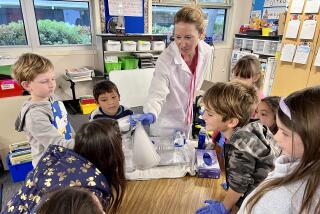Science Education Stuck at Basic Level, Study Says
WASHINGTON â American students are learning the fundamentals of science but they are not developing the sophisticated skills needed to analyze or integrate scientific information, according to a major study released Thursday by the Department of Education.
Education Secretary Lamar Alexander said that the failure of the educational system to rise above basic science education is undermining the nationâs ability to compete in a high-tech world that is increasingly dependent on strong math and science skills.
âWe have a consensus to be first in the world in math and science . . , yet we donât have a priority on science in this country,â he said.
He endorsed proposals contained in the study to improve science-teaching techniques and curriculum, including more âhands-onâ experiments and less textbook study about basic theory.
Further complicating efforts to find solutions for the failures of science education are findings that achievements in science vary widely according to gender, race, home life and other societal factors. For example, children who scored higher on the science tests tended to have better-educated parents, spent less time watching television and expressed enthusiasm about doing science experiments.
âWe do not have a consensus about what the children should know about science. What is enough science for a fourth-grader?â asked Alexander.
The survey found, for example, that in grade 4, 85% of the students understood simple scientific principles. In grade 8, 64% were able to apply those general principles. But by grade 12, despite the completion of college-preparatory level classes, fewer than half had the higher-level skills needed to analyze information and use it to solve problems.
In an example of a basic question for fourth- and eighth-graders, students were asked which gas an animal needs to breathe to remain alive. The choices were helium, hydrogen, nitrogen, and the correct answer, oxygen. Eighty percent of fourth-graders and 93% of eighth-graders answered correctly.
In a higher-level test, 12th-grade students were given four alternatives for determining how much space is taken up by rocks placed in a one-liter container. The correct method was to fill the container holding the rocks with water, pour the water into a measuring cup, then subtract the amount of water from the entire capacity of the container. Only 53% answered correctly.
Eve Bither, Maineâs education commissioner, who was invited by the Education Department to comment on the report, said that the surveyâs results were partly explained by the âabstractâ methods used to teach science in the United States.
A national curriculum adviser, Bither faulted science teachers for relying on lectures rather than involving children in more self-directed projects. She said that children learn to âtalk about science rather than do.â
The report also found that boys outperformed girls in applied sciences by grade 12, yet almost no gender differences were reported for grades 4 and 8.
âItâs our cultural attitude of not expecting girls to learn science. We have to get over that,â said Alexander.
More to Read
Sign up for Essential California
The most important California stories and recommendations in your inbox every morning.
You may occasionally receive promotional content from the Los Angeles Times.










